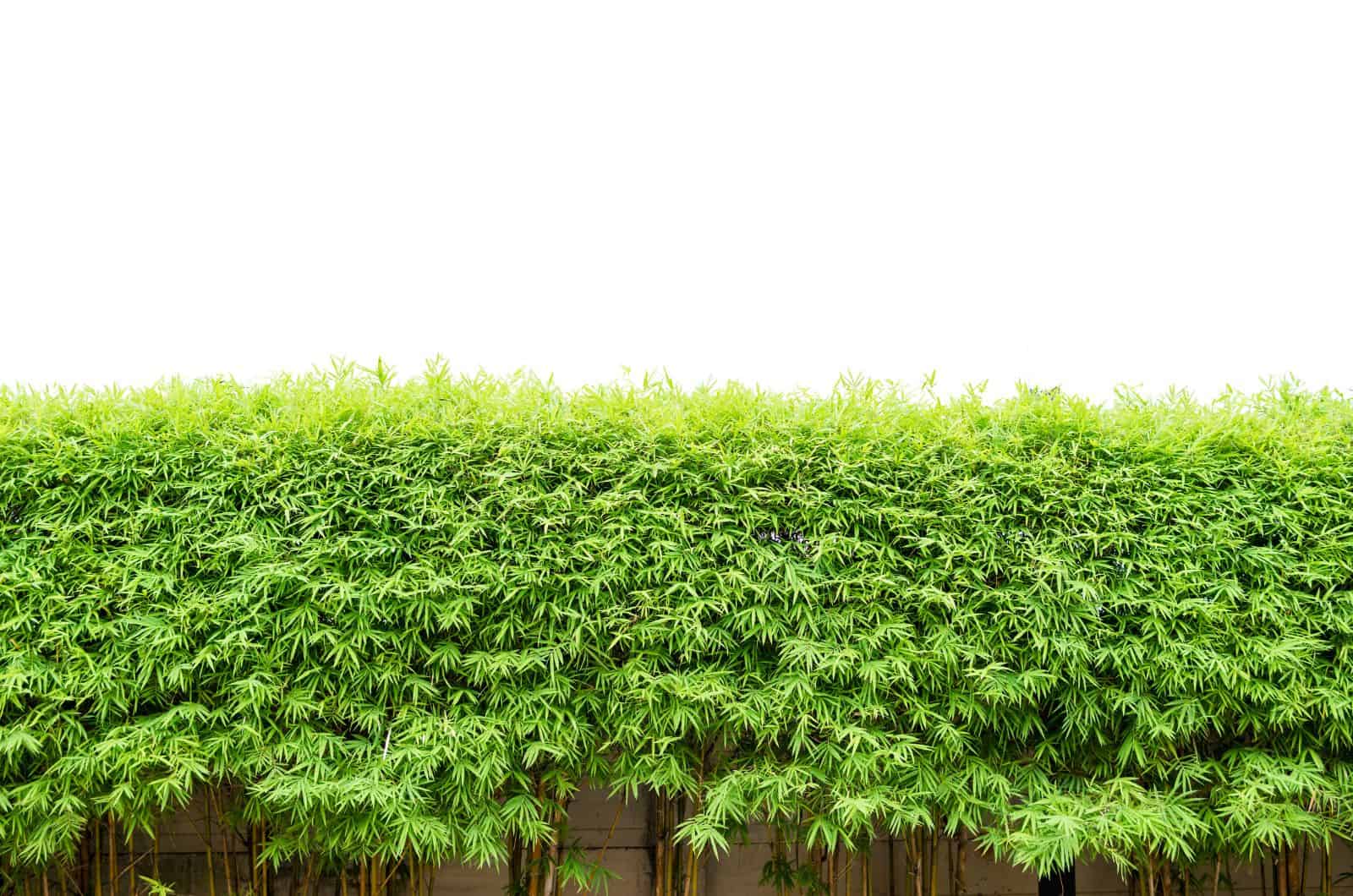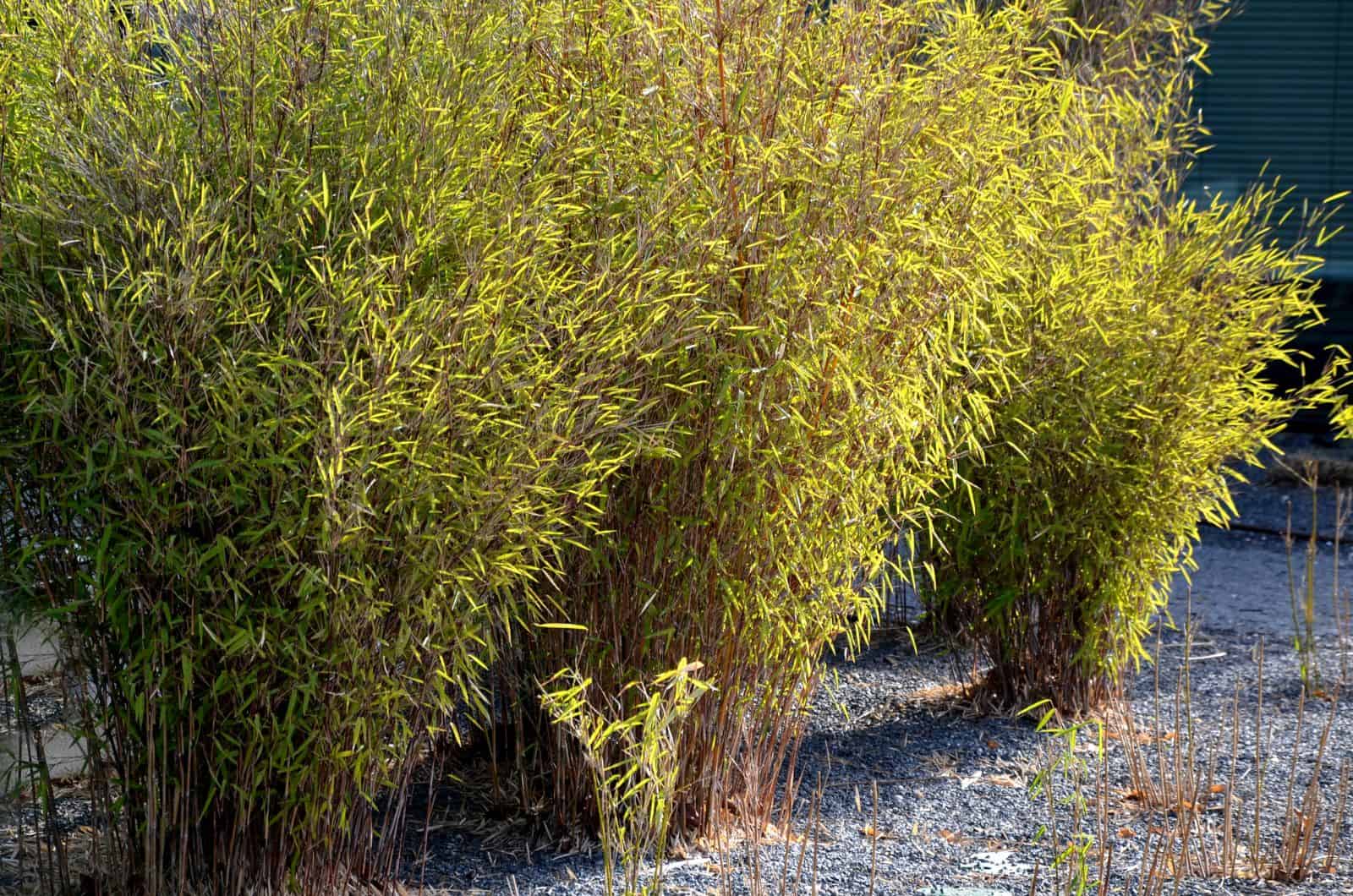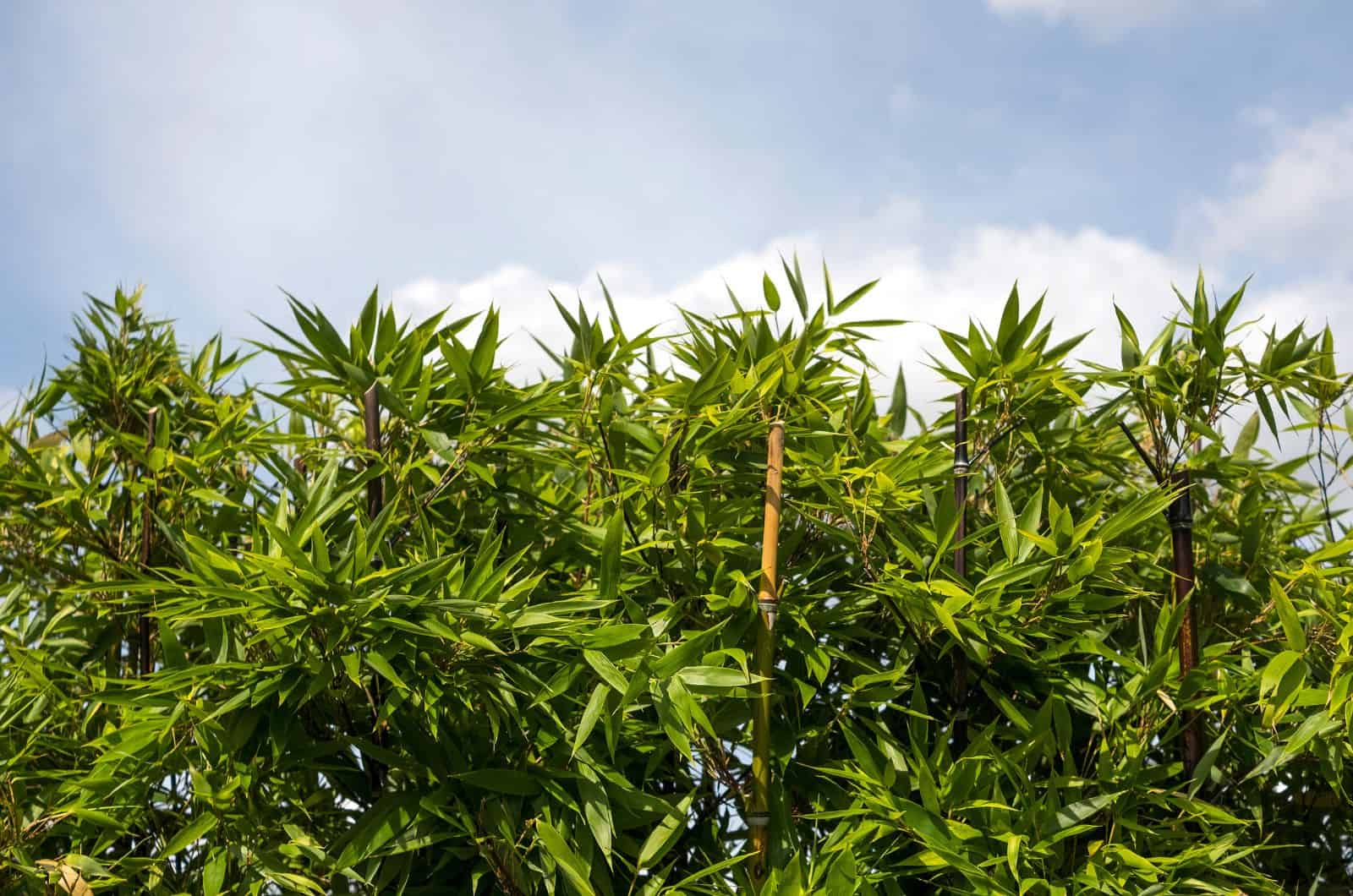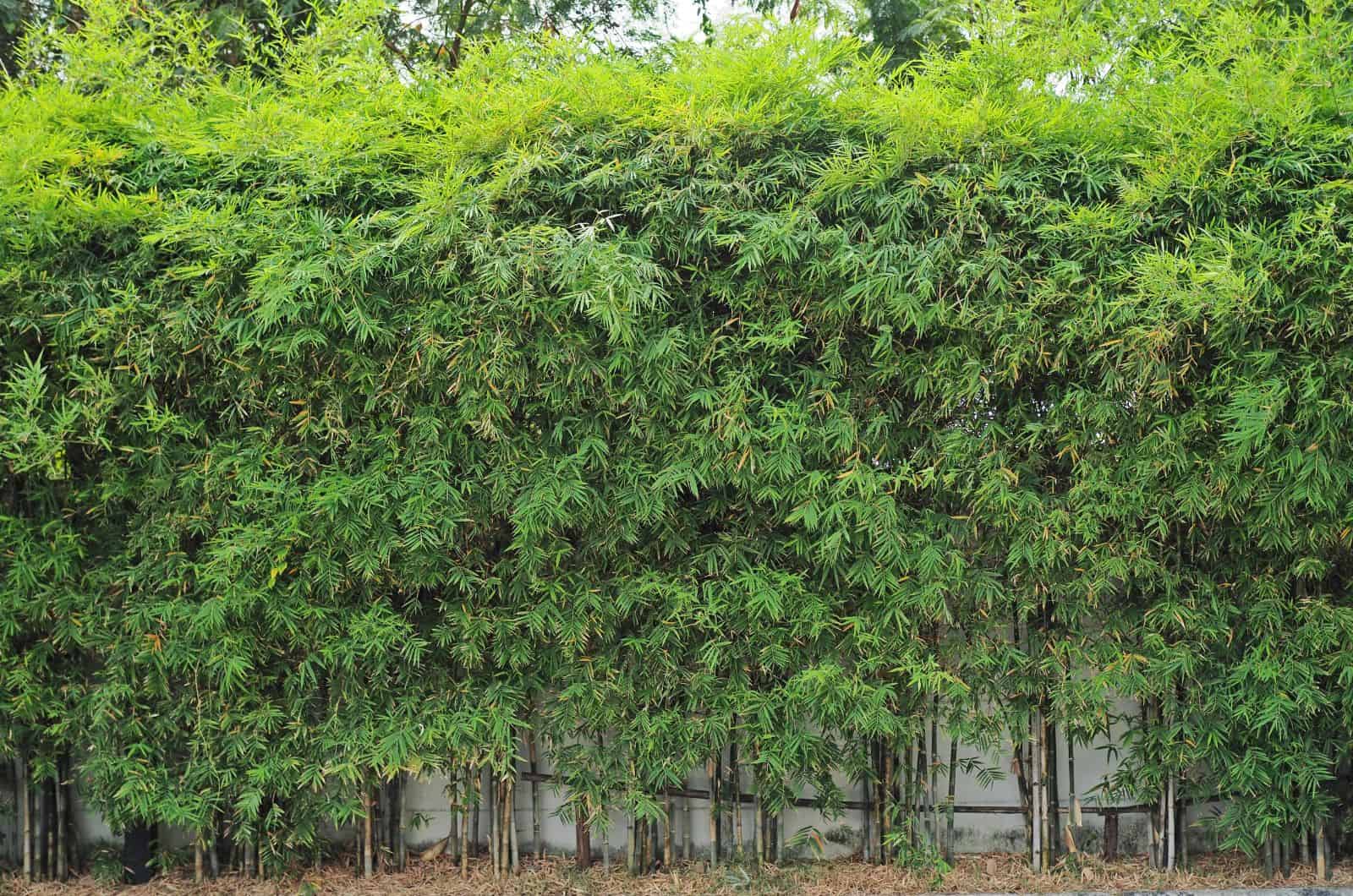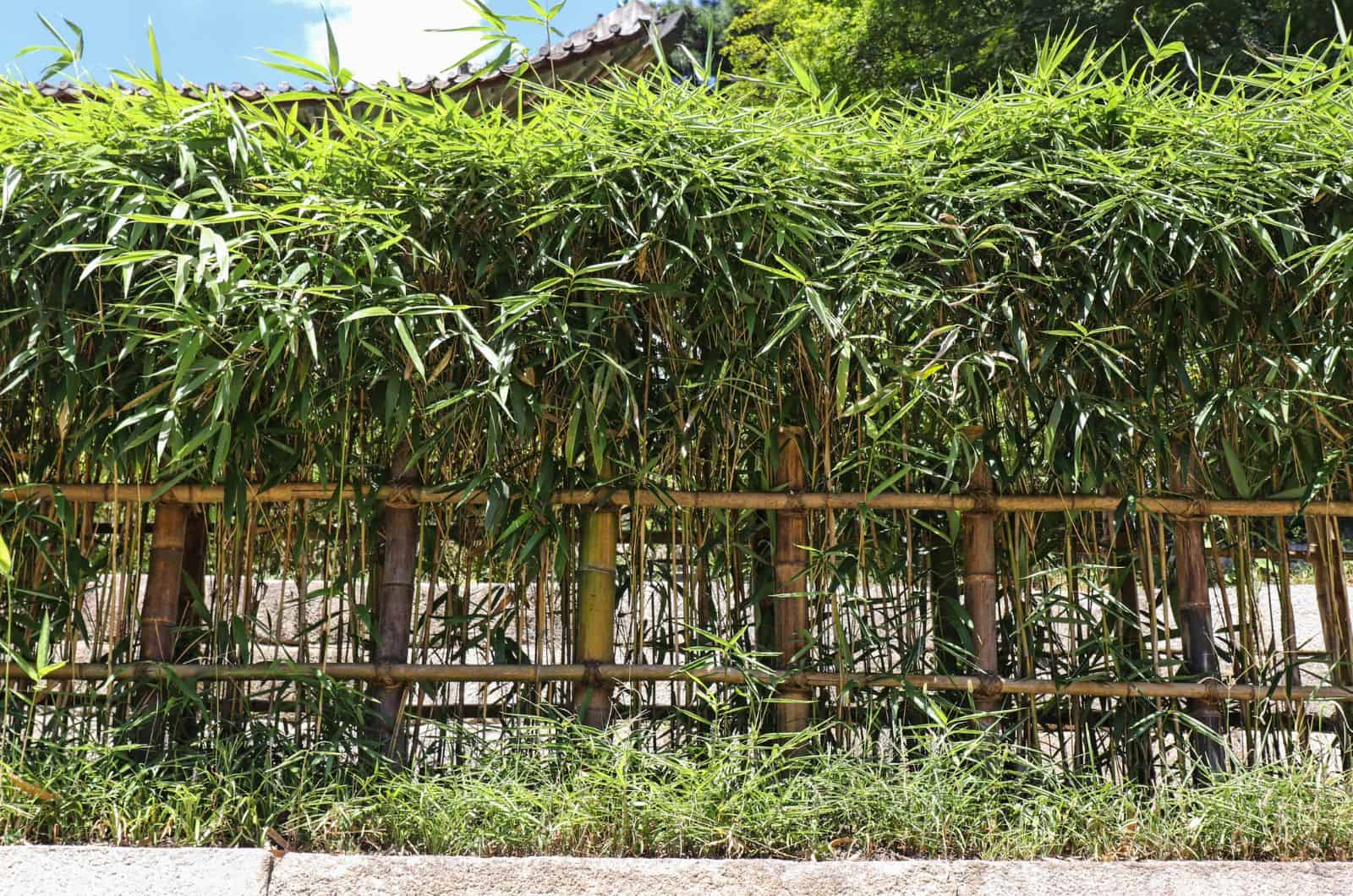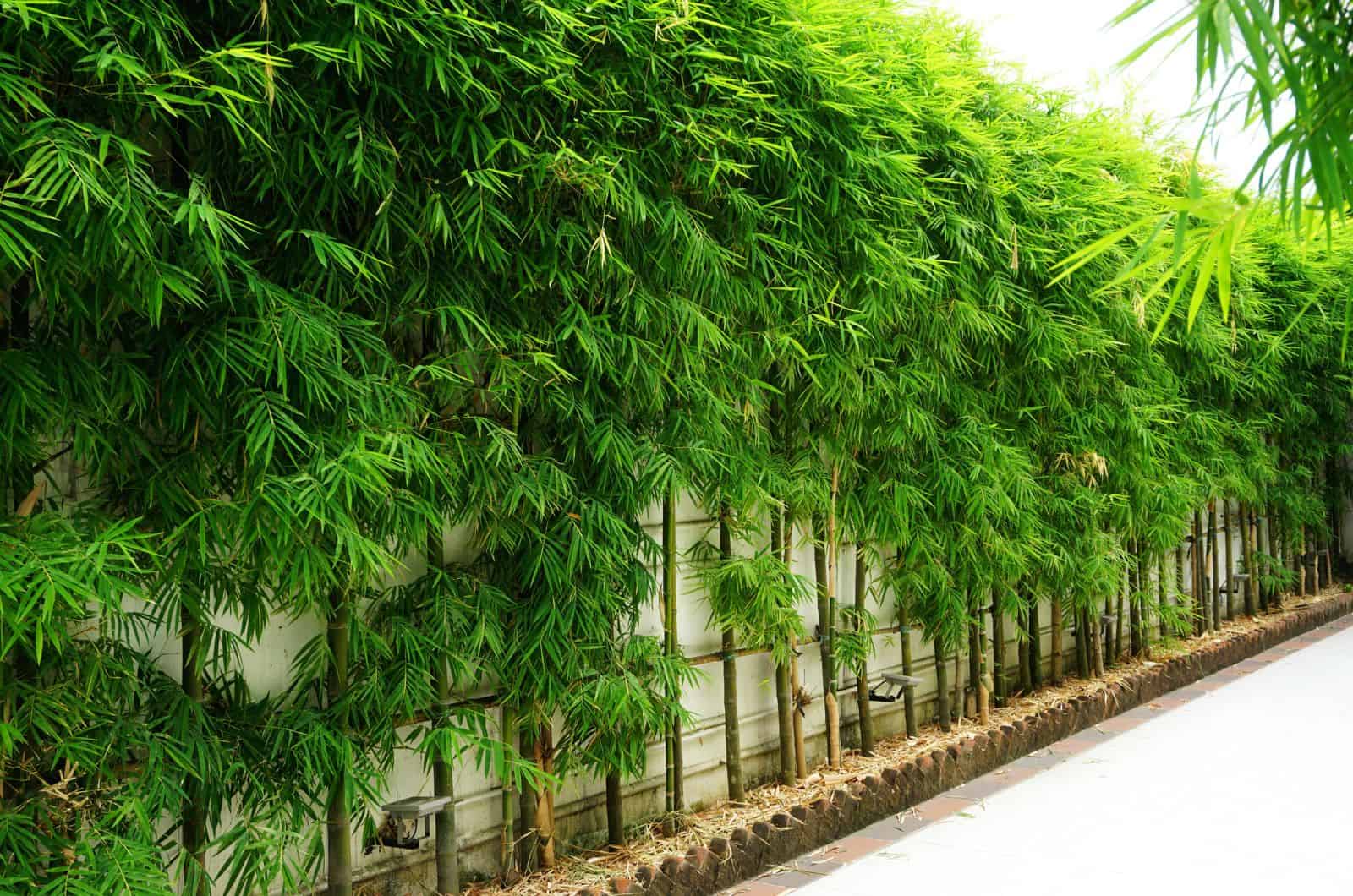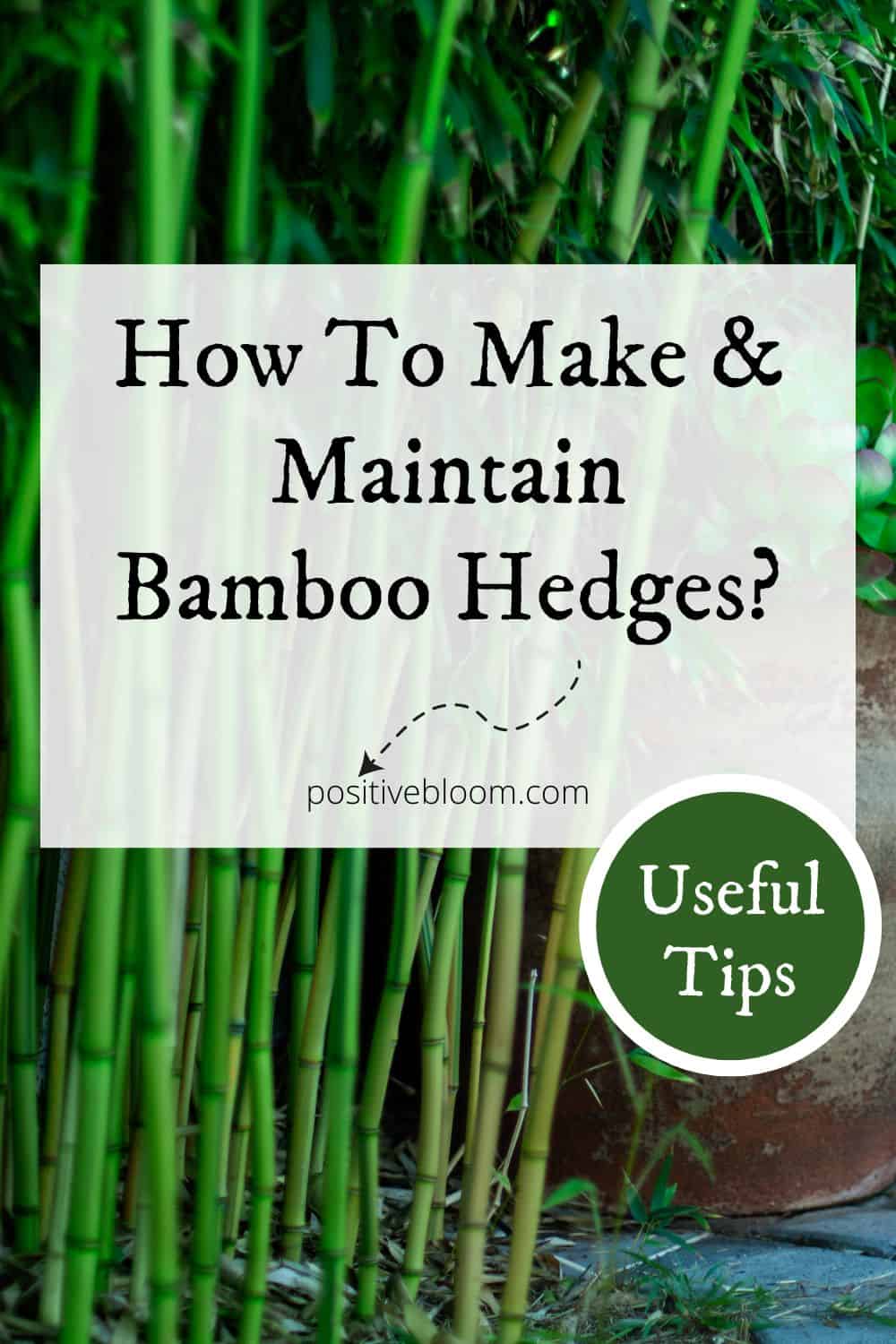Growing bamboo hedges is an excellent way of giving your garden a new look and getting some privacy at the same time.
It may seem a bit difficult to do, as you may not know where exactly to start your live bamboo fence, which variety to choose, or how to plant it.
However, there are a couple of tricks you can learn to help get your bamboo hedge up and running in no time.
The most important thing is to choose the best variety for your climate and the overall garden design. Then, all you’ve got to do is pick a perfect location, prepare the soil, and get planting.
Of course, maintaining a bamboo fence might also seem a bit difficult at first, but we’ve got some tips that’ll help you with that too.
We’ll also discuss the best time to plant this hedge, its benefits, and some common control issues that you might encounter.
So, let’s start because we’ve got a lot of work to do!
How To Make Bamboo Hedges
Choosing a hedge is an important step in every landscaper’s life. There are many pittosporum varieties for hedges, or you can plant a classic boxwood hedge.
However, a live bamboo fence has that something that adds class to your garden.
You do have to consider certain things, such as choosing suitable varieties of bamboo and planting it in a location with full sun so that it can thrive.
You can also choose whether you’ll plant your hedge in planter boxes or in the ground, and both of these choices have their benefits.
Also, soil preparation is equally important since heavy growing mediums can lead to water-clogging and rotting.
If you get all of the above factors right, planting can be a piece of cake!
Choose The Appropriate Bamboo Variety
There are two main species of bamboo, clumping and running, and there are many different cultivars and varieties that you can choose from, whether you want a black bamboo hedge, green, or golden one.
We’ll discuss the most popular varieties in the paragraphs below so that you can choose the best one for your hardiness zone and overall garden design.
Clumping Bamboo
Clumper spreads more slowly than running bamboo and may look uneven, but that doesn’t make it a terrible choice. It is much easier to control the growth of this plant and maintain its shape.
Also, the tallest grass from this plant is giant bamboo (Dendrocalamus giganteus), a variety that is technically a clumper.
But don’t worry; there are many (shorter) clumping types of bamboo that we can use for hedges, and we’ll examine a couple of the most popular ones.
Bambusa Multiplex
Multiplex bamboo (also known as hedge bamboo) is a perfect variety for a privacy screen as it can grow to 10–20 feet. There are many cultivars of this plant, but the ‘Golden Goddess’ is definitely among the favorites.
It doesn’t grow taller than 10 feet, has half-inch woody stems (also known as culms), and is hardy in zones 9–10.
‘Alphonse Karr’ is another popular cultivar and can adorn your garden with its golden-yellow canes streaked with green stripes.
This plant is taller and thicker than the ‘Golden Goddess’ and can make a perfect bamboo privacy screen.
Bambusa Textilis ‘Gracilis’
The so-called graceful bamboo is a great choice for a bamboo hedge in warmer, tropical regions as it is cold hardy down to zone 8b.
It is a compact, easily-controllable hedge plant with blue-green culms and is perfect for all kinds of landscaping designs.
The graceful bamboo has an upright growth habit, can reach 30 feet, and is dense, which makes it an ideal option for a live fence.
Bambusa Malingensis
This bamboo variety is commonly known as the Seabreeze bamboo and is a non-invasive variety that adorns many coastal homes.
It can tolerate salty soils and windy sea-side scenery due to its dense and clumping growth habit and lateral branching.
It is fast-growing (like most bamboo plants) and can easily reach a height of 30 feet, which makes it a quick solution to any privacy issues.
The Seabreeze bamboo is also more drought-tolerant than some other bamboo species, but it isn’t cold-hardy, so you should grow it in USDA zones 8–11, such as Southern California and Florida.
However, another thing that makes growers decide upon this plant is its green canes that may even serve as a windbreak.
Fargesia Robusta
Another non-invasive variety is Fargesia robusta, a plant that usually grows to around 12–20 feet tall. It has a fast growth rate, especially if it’s grown in its preferred climate (USDA zones 7–9).
It is hardier than the other bamboo species we have mentioned and has an interesting appearance; Fargesia robusta’s culms have a checkered pattern of white and dark green throughout its growing season.
Running Bamboo
Choosing running varieties of bamboo plants for a fence is a better choice if you’re in a hurry and need a hedge ASAP.
These plants are perfect for budget zen garden ideas since they are among the fastest-growing plants in the world and can quickly get you the result you’ve been waiting for.
However, they can be invasive, so you should place some mulch in the planting location to create a rhizome barrier and prevent it from driving out (and suffocating) your other plants in their habitat.
Phyllostachys Aurea
This fast-growing plant is also known as golden bamboo or even fish-pole bamboo. It can be taller than 20 feet, making it a perfect choice for a bamboo fence.
The lower culms of this plant have a lovely golden-green shade and defined internodes, while the top is decorated with vibrant green foliage.
It is a cold-hardy bamboo that can flourish in USDA zones 6–10.
Phyllostachys Nigra
This black bamboo is probably one of the most popular bamboo plants out there simply because of its color. However, not all cultivars have entirely black canes; some are more gray-green (such as Henon), but that only adds to its allure.
It usually grows to around 30 feet tall, with 2-inch culms, but you can prune it to make it more suitable for a hedge.
Phyllostachys Bambusoides
This plant is known as Japanese timber bamboo, giant timber bamboo, or madake, and it can grow up to 50–70 feet tall, with 10-inch canes.
It is one of the best bamboo privacy plants since it can hide entire houses, not just balconies and patios.
However, it might be challenging to control due to its fast growth rate and height. On the other hand, it isn’t as invasive as some other running varieties, and its dark green culms are rather attractive and difficult to resist.
All in all, you’ll have to weigh up the pros and cons and decide if this plant is worth it.
(You know, you can always cut some canes to make your own DIY bamboo poles for climbing plants or bamboo blinds!)
Pseudosasa Japonica
Unlike Japanese timber bamboo, the Pseudosasa Japonica, or rather arrow bamboo, is invasive, and you have to monitor it closely and be very vigilant in order to stop it from suffocating your other plants.
It usually grows to around 15–20 feet tall, with beautifully thin canes (which are less than an inch thick).
You can grow a nice bamboo hedge and a shorter privacy screen even in colder climates as it is hardy down to zone 7.
The new shoots and younger canes have a gorgeous olive green color which turn browner and browner as they get older.
Choose The Location
Once you’ve chosen the bamboo plant that you wish to grow, it is time to move on to the location.
These grasses prefer full sun conditions and need at least six hours of sunlight each day for optimal growth.
There are varieties and cultivars that can handle some shade, but generally speaking, bamboo plants need plenty of light in order to grow more foliage.
Furthermore, taller varieties will need more light to grow properly and produce as much foliage as they can.
Therefore, ensure that your bamboo hedge isn’t shaded by other tall trees, which will obstruct the sunlight and make your plants thinner at the base (which is not something we strive for when growing a live fence).
Finally, don’t plant the bamboo plants closely together. We’ll discuss the proper spacing in the planting section, but for now, you should know that densely planted bamboo doesn’t get enough light and will be thinner (or even leafless) at the base.
Prepare The Soil And Site
Bamboo plants prefer fertile and well-draining soils with slightly acidic or neutral pH levels.
If your native soil is rather porous and alkaline, you should add some organic content such as compost and certain acidifying materials, such as peat moss, ammonium sulfate, etc.
However, if the soil is too acidic, you should add some lime to increase the pH and get closer to the neutral level (7.0).
On the other hand, clay and heavy soils are equally bad as they retain more water and can lead to root rot, killing your bamboo hedge. To amend this growing medium, add some organic material and sand to make the substrate more draining.
Finally, if you wish to grow your bamboo plants in planter boxes and containers, you should use high-quality potting mixes with excellent drainage.
Planting
Once you’ve prepared the soil, it is time to plant the bamboo. The most important thing you need to bear in mind is how to space the plant properly. If you don’t give this plant enough room to grow, its base won’t get much sunlight and will be bare without any foliage.
However, the exact spacing depends on the variety of the bamboo. If you have decided to grow a running bamboo fence, you should plant the sapling around five feet apart. On the other hand, clumping bamboos don’t require that much space, and planting them three feet apart is more than enough to create a suitable hedge or privacy screen.
Of course, growing bamboo in planters is another option for ensuring good conditions in which it can thrive and develop dense foliage.
But spacing is not the only important thing you should pay attention to. You should be very careful when transplanting the bamboo you have just gotten from the garden center as you don’t want to damage its root ball.
The rhizomes and roots of this plant don’t grow all the time, so your bamboo will have a difficult time recovering (unlike veggies and some other plants).
And the last thing we’ll examine is the depth of planting. You should always dig a deeper hole so that you can plant the bamboo a bit deeper than it was in the pot.
Add some compost, water them deeply, and that’s it!
Here is a video that’ll help you get started with your bamboo hedge:
When To Plant A Bamboo Privacy Hedge?
One of the interesting things about planting bamboo is that you can do it at any time of the year.
However, transplanting the saplings is best done in spring and fall when the temperatures are mild, and there is less possibility of the plant falling into a state of shock.
You can even plant the bamboo in winter in warmer regions, but if you live in colder climates, wait until spring.
Finally, there’s nothing wrong with replanting this tall grass in summer, although higher temperatures will make it more thirsty, so you’ll have to irrigate it more frequently.
Maintaining A Bamboo Hedge
One of the things I love about live hedges is that they give a whole new look to your garden. Take a lavender plant hedge, for example; it smells amazing, looks fabulous, and repels some insects, deer, etc.
But it does come with certain requirements! Living fences, such as pittosporum, bamboo, boxwood, or lavender hedges, require regular maintenance to look their best.
That includes regular pruning, watering, and fertilizing, depending on the plant’s needs.
And that’s what we’ll examine in the following sections, so stick around!
Care Guide Overview
Good soil and full sun conditions are a great start, but that’s not all your bamboo hedge needs.
Watering and fertilization are also important, and we’ll discuss them briefly in the following paragraphs.
But before we get to these requirements, let’s examine one other thing that helps with both of them, mulching.
Applying a layer of mulch around your potted or in-ground bamboo plants will reduce the evaporation speed, keep them warm in winter, and if you use organic mulch such as the bamboo’s own leaves, it will decompose and enrich the soil with nutrients, promoting further development.
Watering
Bamboo requires a bit more care during its first year, so you’ll have to water it more frequently. For instance, it’s not so strange to have to irrigate this plant 3–5 times a week while it’s still young.
But once it gets established (during its second or third year), bamboo will need less attention. If you live in a rainy region, you won’t have to water it at all other than during dry spells.
Established bamboo plants need an inch of water per week, so don’t forget to irrigate them deeply at least once a week.
However, potted plants tend to dry out more quickly, so you’ll need to water them more frequently. You might even have to irrigate these plants every day if the weather is scorching.
Fertilization
Bamboo is grass, so you’ll do best for your plant by using a nitrogen-rich grass fertilizer such as 20-5-10 three times a year. Remember to always feed your bamboo during its growing season—in spring and summer.
But if you grow this plant in a container, you should feed it with a weaker plant food such as an 8-2-2 custom-made bamboo fertilizer. Too many minerals in the soil can burn your plant’s roots, which is not something anyone wants to deal with.
Another way to avoid fertilizer burn is to water the bamboo plant before feeding it.
Pruning
The rule of thumb is to trim the bamboo plants whenever the new shoots aren’t protruding from the ground. But most growers trim these plants in late winter or early spring as they can be certain there’s no new growth then.
If you want to get rid of the old, dead, and unattractive canes, you can simply take a saw and cut them to the ground, while the dead branches can be trimmed at their base.
You can also remove a part of the stem, but in this case, you should cut it just above the node to encourage further growth and prevent dying back.
Another way of controlling your bamboo plant’s growth is trimming its top. However, don’t forget to shorten the lateral branches as well to give your hedge a more rounded (or rather, squared) look.
But trying to make the bamboo smaller will take away some of its unique grace, so do it only in dire need.
Here are some more simple tips for pruning bamboo:
Benefits Of A Live Bamboo Fence
There are many different tall potted plants grown for privacy, but bamboo is definitely among the most popular ones.
It has many benefits, such as serving as a privacy screen (obviously), windbreak, and a noise barrier.
Planting bamboo privacy screens is relatively easy as it doesn’t require frequent irrigation, and you can even use the canes for making your own bamboo stakes and trellises.
One of the benefits of using bamboo for a hedge is that it doesn’t require pesticides, herbicides, or any other chemicals for healthy growth, so the surrounding flora will also remain intact.
It grows quickly, reduces soil erosion, and produces more oxygen than trees.
Finally, it uses more CO2 than any other plant on the planet, so why not help the environment while we’re at it?
Dealing With Control Issues Of Bamboo Hedges
Of course, everything’s not peachy about the bamboo plant, and one of its drawbacks is its invasive nature.
Thankfully, clumping bamboo spreads slowly, so your other plants won’t be in any serious danger.
However, running bamboo is a different story! This variety is invasive and will push out the other plants you might have in your garden if you’re not careful.
Thankfully, there are some ways of containing this species to a certain area, such as creating rhizome barriers, trimming the roots, or in the worst-case scenario, growing it in a container.
We’ll briefly discuss each of these options, so you can choose the best one for your garden.
Create A Root Barrier
One way to control the spread of bamboo is to install a rhizome barrier, such as polyethylene plastic.
The first thing you need to do is establish how deep the plant’s roots go, and the only way to do this is to start digging. But you shouldn’t stop digging once you see the endings of rhizomes.
The barrier has to be set about a foot deeper than the plant’s roots in order to be able to contain them.
Afterward, dig around the bamboo and place the plastic so that 2 inches are above the ground. This technique will help with the rhizomes that have decided to go over the barrier, and you’ll be able to trim them easily.
Trim The Roots
Of course, using a plastic barrier is not the only way to subdue this plant. If your plant is still young and you don’t mind tending to it daily, you can trim its roots and stop them from spreading.
Just dig a trench around the bamboo plant and cut the roots that try to go over it.
However, this method has its downsides, and aside from having to tend to the plant every day, it will also taint the look of your landscape design (if you’re not going for a medieval style, that is).
But don’t worry, there is another technique left that doesn’t involve trimming or using plastic.
Grow The Bamboo In A Container
Growing bamboo in a planter box is one of the easiest ways to stop it from invading your garden.
Of course, you will have to choose massive pots (eventually), but if you’re starting with a tiny seedling, a smaller container is just fine.
You do have to ensure that the pot has good drainage since this plant is susceptible to root rot. However, some drainage holes at the bottom of the planter and loose soil are quite enough.
Frequently Asked Questions
Believe it or not, there are some more questions about bamboo hedges and their growth.
We’ve picked out a few questions that you’ve asked us most frequently, and we’ll answer them in the sections below.
How long does a bamboo hedge take to grow?
Certain bamboo species, such as Phyllostachys, can grow 35–40 inches a day, meaning that they can reach a height of 8–10 feet in about 2–3 years.
Bamboo is also famous for spreading, and whichever type you plant, clumping or running, it will take about three years for the hedge to form.
Of course, you should plant clumping bamboo closer together, as it spreads less and more slowly than the running one.
How much does a bamboo hedge cost?
You can get a single bamboo starter for about $15–$30, but established varieties cost much more (a 15–25 feet tall bamboo can cost anywhere between $250–$500).
However, this plant grows very fast, and you can save a lot of money by getting bamboo starters. You will have to take a few of them, but if you opt for a running variety, you’ll need fewer plants.
The best way to determine how many plants you’ll need is by dividing the total number of feet by 5 or 3 (the number of feet between each plant).
Then, all you need to do is multiply the number by the price of a single bamboo, and you’ll get the total amount you need to invest in your bamboo hedge.
How many bamboo plants does it take to make a hedge?
This depends on the space, but what you need to do is measure the total number of feet and then divide it by three or four (the spacing between each plant, which depends on the bamboo type).
Wrapping Up
This article brought you a couple of tips for planting and maintaining bamboo hedges, such as how to choose the most suitable variety, how to prepare the soil and choose the best location, and, of course, how and when exactly to plant it—to which depth, that is.
But planting is only half the trouble. The real job is maintaining the bamboo hedge, which can be challenging at times.
You do need to feed and water it regularly, and don’t let me start on pruning!
But these are all sweet troubles, especially when you see the end results. That’s why we included the benefits of bamboo hedges, so that you know it’s all worth it.
Have a great time behind your new privacy screen, and until next time!
Like this post? Share or pin it for later!

